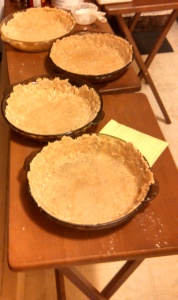
Don’t freak out. You can totally make a piecrust.
It’s not actually that hard. I don’t know how the idea that piecrust is mysterious and difficult has gotten around, but it certainly has. I used to be very intimidated by piecrust, convinced I’d mess it up somehow and that there was something, nature or nurture, that gave other people certain piecrust know-how that I could not access.
Piecrust is really just a matter of science, practice and patience. It contains, at it’s core, three things: flour, fat, liquid. With a couple of tricks, you’ll be rolling with the best of them in no time.
Things You Need to Make a Piecrust.
- A trusty pie crust recipe.
For Seven Pie Mountain, we used A’s grandma’s old, top-secret, very special recipe. AKA, the one from the Crisco can. It’s very simple. Two cups of flour, two-thirds of a cup shortening, quarter cup of water. The original Crisco one includes salt, but we didn’t. I’ve also had great luck with the single pastry crust recipe in Veganomicon, which includes apple cider vinegar, and the olive oil crust in Vegan Pie in the Sky.
- A rolling pin, or something that works like one.
A good wooden rolling pin is my weapon of choice, but you can use something else. I’ve rolled cookies out with a drinking glass, and A says her grandma’s first rolling pin was a sawed-off broom handle. Anything solid and cylindrical will do the job. But if you see a lot of baking in your future, find yourself a rolling pin. Thrift store kitchen sections may be your friend here, or fancy kitchen stores, if you, too, are fancy. You can spend as little or much as you want.
- A surface for rolling.
Trying to roll out pie crust on a surface that is too small leads to much sadness and banged elbows. Make sure you’ve got enough room, even if you have to move it to the dining room table, or a piece of clean cardboard on the floor.
- A pastry cutter (preferred) or two knives, or a knife and a fork.
A pastry cutter is a nifty little hand-held device with several u-shaped blades, used to combine flour with fat. They are not expensive, and they are really, truly, the best tool for the task, as far as I’m concerned. However, if you don’t want a gadget or hate cool things, go ahead and use two knives, or a knife and fork to cut and cut and cut the flour and fat together. See what I care.
- Extra points: parchment paper. Wax paper in a pinch.
Some people are: A) very skilled piecrust rollers or B) don’t mind making a really big mess. If you, like I, are neither of those things, then parchment paper is going to be very useful for you. You can, conceivably, flour your surface, roll out the crust directly onto it, and take it from there. That would be the most vintage thing to do. A’s grandma could roll her crust out onto the counter, pick it up with the rolling pin, and toss it into the pie plate, but people aren’t raised to be that badass anymore. However, to retrofit, I suggest using parchment paper. I used to use wax paper, but A taught me a better way, and I saw the light.
Methodology
Making Crust.
Whatever your recipe, it will probably work like this, unless you’re doing something very specialized, like making a gluten-free piecrust.
- Make sure your ingredients are nice and cold, especially the liquid. In the summer, I even chill my flour.
- Measure out your dry ingredients (for us, that’s 2 cups of all purpose flour) in a large bowl.
- Measure out your fat, into the same bowl (two-thirds of a cup of shortening, if you’re using ye olden tymes Crisco recipe).
- Cut the fat into the flour. This means you chop it and chop it and chop it together, until it gets all pebbly.
- Add the cold water, a splash at a time.
- Mix it up. I’ve always stirred with a fork, but A is much cooler, and she mixes it with her wet hands. This way is faster. Much faster.
- When it’s all combined in a ball, without pieces falling off, you’re ready to roll.
- Divide into two balls, and get rolling.
Rolling the Crust.
Here is A’s method, which is pretty impressive in its simplicity:
- Take two big sheets of parchment paper. Place your ball of piecrust between them.
- Roll the crust out with your rolling pin, on top of the top sheet of paper–making a piecrust-paper sandwich. Turn the paper so that you can roll in each direction, making the crust mostly round. A is better at this than I. I usually do a sort of round crust and then patch it together.
- Then, oh, then, peel off the top sheet. Place your pie plate on top of it, upside-down.
- Place one hand on top of the pie plate, and use the other to gently pull the entire thing over the edge of the counter, just enough to reach underneath it.
- Now you have one hand on each side of the pie plate, one holding the plate, and the other gently pressing the center of the crust. Flip over the plate.
- Peel up the second sheet of parchment paper.
- Holy cats, you just put in your bottom crust without mess or fuss. You are a domestic goddess, regardless of your gender.
- Put the filling of choice into the pie crust.
- Use the same parchment paper to roll out another crust.
- Peel off the top sheet.
- Flip it onto the pie.
- Peel off the back parchment.
- Tuck in the edges.
- Bam! Double-crust!
Finishing Techniques
There are many ways to finish your pie, but they come down two elements: sealing the edges, and venting the crust.
Sealing techniques include: pinching, forking, fluting, spooning, scalloping, and roping. In addition to all sounding like something that happens in the backseat of a car at the end of a country lane, all of these accomplish the goal of joining the bottom and top crust into holy pie-tramony. Be as complicated as you want to be, but I usually just kind of pinch everything together and call it a day.
Venting simply means cutting some holes in the top crust to allow steam to escape. This stops pie explosions and filling leaking out all over the place. Again, you could cut out the shapes of turkeys and pilgrims and pine trees, but I usually just stab it a few times in the center.
Troubleshooting
In baking, as in life, sometimes things will go wrong despite your best intentions. Here are some things that commonly go wrong for me.
I added too much water, and now my dough is somehow both sticky and slimy! Everything is ruined!
Before you throw it away in disgust, let it sit for awhile, and it might dry out a bit.
My dough is still crumbly! Everything is ruined!
Calm down, and add more water, a teensy bit at a time.
My bottom crust doesn’t cover my pie plate or come all the way to the top! Everything is ruined!
Nothing is ruined. You can patch it with pieces of your top crust, which doesn’t need to be as big anyway. Just pull off or cut the amount you need to cover the gaps and press them in. You can even dip your finger in cold water and run it gently along the seam to seal it, if you’re dedicated.
Everything is sticky, and the dough is rubbery and I dropped it on the floor and I hate the world!
Dude. Throw it away and start over. It’s a piecrust–it takes 10 minutes to make and three cups of ingredients that aren’t really expensive. Let it go.
Questions? Recipes? Piecrust horror stories? That’s what the comments are for!

I use my food processor to mix the dough and then chill it again afterwards. The cooler you can keep the dough the flakier it will come out. I do agree it isn’t that hard to make a really great piecrust at home.